When you want to decode, encode, transcode, mix, demix, stream, filter, and play, then FFmpeg is probably the best tool for the job, and it’s available for Windows 10 as a free download. However, it should be noted that FFmpeg is a command-line program; therefore, if you have no experience using the command line, you may feel out of your comfort zone and ultimately decide to use another software. That’s not something we want; therefore, we went out in the wilderness to seek out a graphical user interface for FFmpeg, and luckily, we found one. The tool in question is called FFmpeg Batch A/V Converter, and it works quite well. With this program, there’s no need to type in the command line all the time; just a few clicks of the mouse and you’re good to tango.
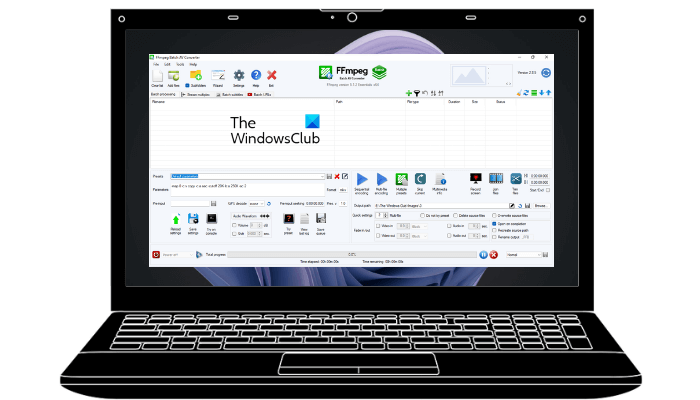
FFmpeg Batch A/V Converter
FFmpeg Batch Converter is a Windows front-end for FFmpeg users, that allows using the full potential of FFmpeg command line with a few mouse clicks in a convenient GUI with drag and drop, file details, progress information.
Download and install FFmpeg
Before going forward with the installation of FFmpeg Batch Converter, you must first download and install FFmpeg. Do this by visiting the official website, and from there, navigate to Get the packages, select the Windows logo, then click on Windows Builds.
Finally, choose your architecture and close it off by clicking on the download button. The file size is close to 70MB, and it comes packaged in a ZIP folder. You will need to unzip the folder and leave it as it is.
Download and install FFmpeg Batch Converter
Visit the official page at SourceForge and kickstart the download. Bear in mind that depending on the security settings of your Windows 10 install, you might have problems completing the download.
We suggest using Microsoft Edge for this task. Now, the system won’t be able to verify the software, so click on Run to install. After that, launch it and let us get down to business.
- Add Files
- Convert Files
- Edit Videos
- Record Screen.
1] Add Files
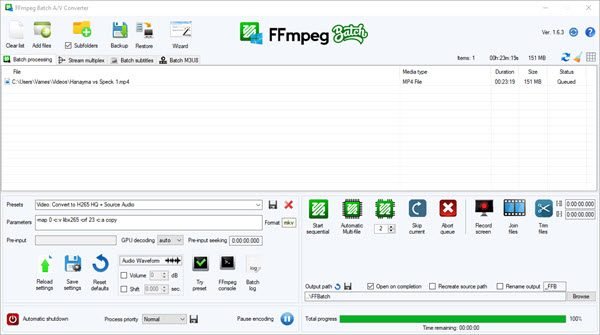
Adding files for conversion is very simple, and probably the easiest thing to do. Just click on the Add files button, search for the ones you want, and hit the OK button to add them to the table. After doing that, you’ll see that the file or files are queued. Now, if you right-click on the file, the option is there to play, remove it from the table, view media information, and more.
If you have added video or audio files for conversion in a particular folder, you can add all the files simply by selecting that folder. Go to “File > Add folder” and select the folder containing audio or video files. If the selected folder has subfolder(s) containing video or audio files, those video or audio files will also be added to the conversion list. If you wat to exclude the subfolders, uncheck the Subfolders checkbox on the ribbon.
2] Edit Videos
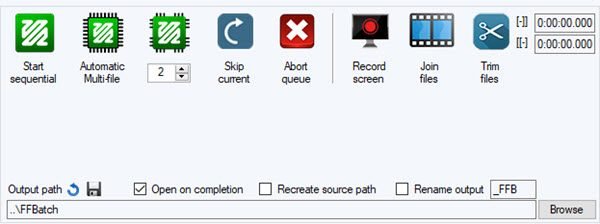
Here’s the thing, FFmpeg Batch Converter is not the tool you should turn to when the need arises to edit videos. The options here are very basic. Therefore, it’s just not ideal. However, if you’re just looking to trim and join files, well, you’re in the right place.
If you have two video or audio files on the table, the option is there to trim or join them together to create a single video. The buttons are located in the right section of the program and at the bottom.
3] Convert Files
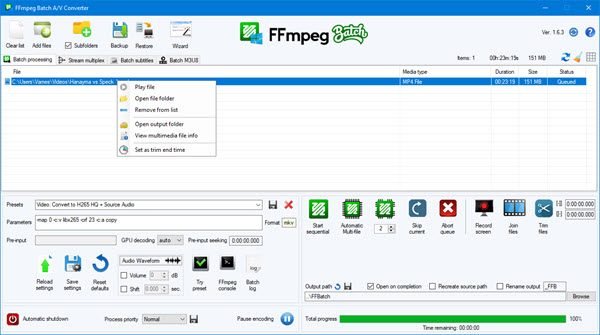
After adding the files for conversion, it’s time to convert them to the preferred format. Go to Presets and select the right format, and from there, you can decide whether or not you want to change the audio waveform.
As for GPU decoding, this can be set to auto or any other option, but we suggest auto if you have no idea what you’re doing. The final thing before beginning the process of converting the file is to set the priority. This will determine the number of system resources used to get the job done.
The next step, then, is to click on the Sequential encoding button, and simply sit back and wait for the FFmpeg Batch Converter to finish the job.
The Multimedia info option provides you with the details of the selected audio or video file. Select an audio or a video file from the list and then click on the Multimedia info. A new window will open showing you the details of the selected file, like file size, duration, format, format profile, bit rate, color space, etc.
You can also skip the conversion of a video or an audio file while the conversion is in process. For this, click on the Skip current button while the particular file is being converted. After doing this, its status will be shown as Skipped.
4] Record Screen
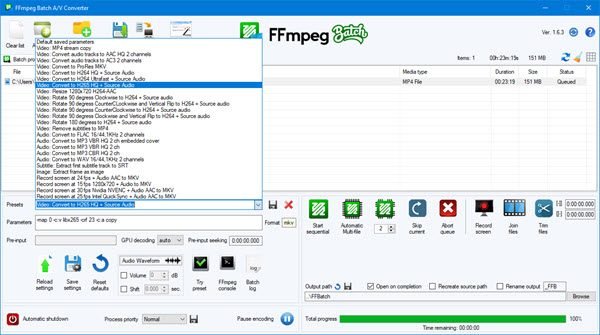
Now and again we all tend to have something on our computer screen that needs to be recorded. Thankfully, the tool we’re talking about today comes with such an option.
To activate it, click the Record Screen button, then choose whether or not audio is needed, then finally hit Start Screen Capture.
How to use FFmpeg command?
FFmpeg is a powerful command line tool that can convert audio and video files from one format to another format. You can run it via the Command Prompt on Windows 11/10. But before this, you have to download and set up FFmpeg on your system. After setting up FFmpeg, you can use it for the conversion of audio ad video files. For this, open the folder containing your audio or video files, click on the address bar of File Explorer, type cmd, and hit Enter. This will open the Command Prompt in the selected directory. Now, use the following command to convert your files:
ffmpeg -i "file name with extension" "output file name with extension"
For example, if I want to convert an mp4 video file with the name A to flv, the command will be:
ffmpeg -i "A.mp4" "B.flv"
How do I batch convert files with FFmpeg?
To batch convert files with FFmpeg, go to the folder where the files are located. Now, click on the address bar of File Explorer and type cmd. Hit Enter. This will open the Command Prompt in the selected directory. Now, use the following command to carry out batch file conversion with FFmpeg:
for %i in (*.mkv) do ffmpeg -i "%i" "%~ni.mov"
In the above command, mkv files are converted into mov. Replace the file extensions accordingly.
Let us know how you like enjoying this tool.
Read next: Best Free Online Video Editor.
Leave a Reply